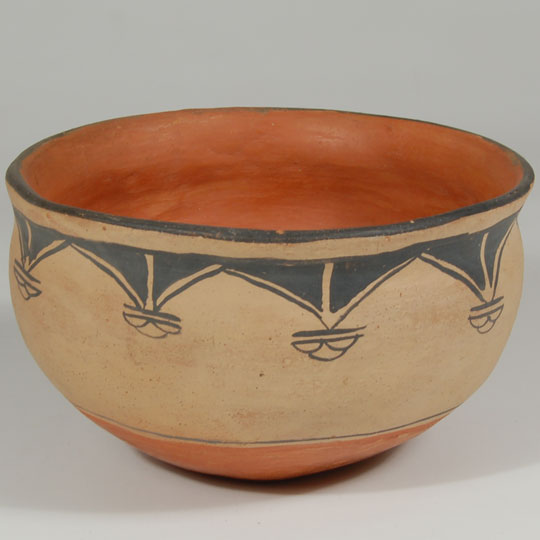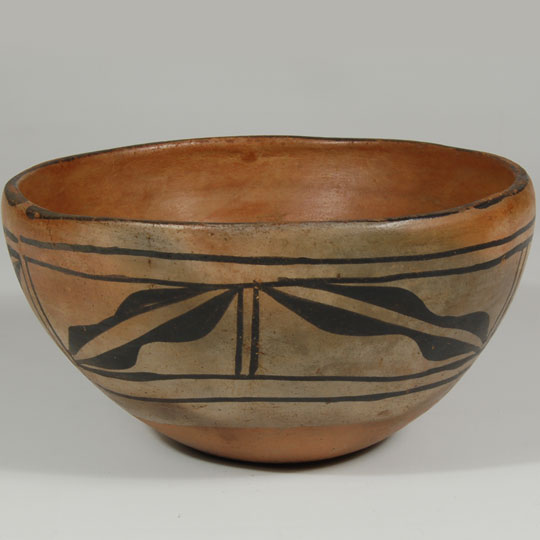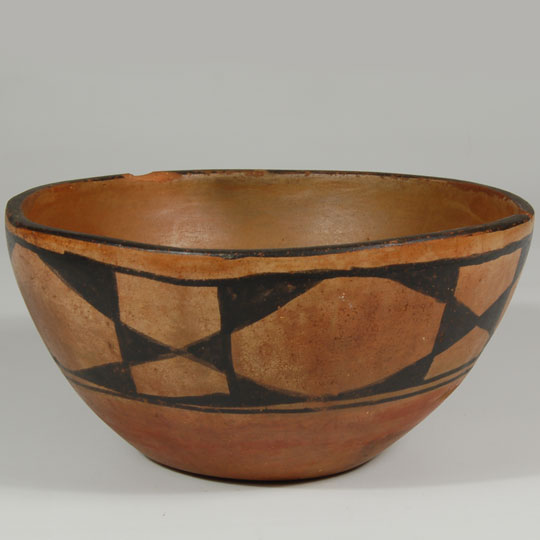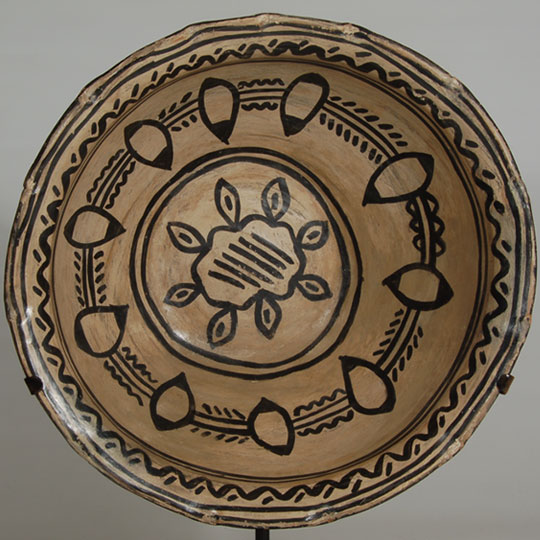Brown Bear Storyteller Figurine with 5 Cubs by Maria Priscilla Romero - C3688.38
Maria Priscilla Romero credits her mother, Maggie Chalan, and her mother-in-law, Teresita Romero, with teaching her the rudiments of pottery making. She has been an active potter since 1979.
Read more about this storytellery here.
Hopi Third Mesa Wicker Plaque with a Turtle Design - 25455
Animals, birds and other natural objects are often presented as imagery in Hopi basketry. Here, a wonderful rendition of a turtle is presented.
Read more about this basket here.
Black Carved Santa Clara Jar with Avanyu by Christina Naranjo and Mary Cain - C3757B
Occasionally, members who work together will co-sign the finished items. That is the case with this jar. Mary Cain was a daughter of Christina Naranjo and it is most likely that Mary greatly assisted her mom with this jar. Christina was 89 when she passed away in 1980 so it is likely that she needed assistance in polishing pottery as it is a laborious affair. Mary Cain was 95 when she passed away in 2010 but would have been considerably younger at the time this jar was made. The jar is co-signed with the names of both mother and daughter.
Read more about this pottery here.
Hopi Beautiful Large Polychrome Jar by Helen Naha - Feather Woman - C3757C
Helen Naha was a Hopi-Tewa of the Spider Clan. She was a self-taught potter who developed her own designs and styles primarily based on prehistoric pottery shards from the Awatowi ruins.
She and Joy Navasie (Frog Woman) were sisters-in-law. Helen married Joy Navasie's brother, Archie Naha. Helen was known for her stark black-on-white Hopi pottery early in her career and for exquisite polychrome pots in later times. Her signature is comprised of a feather design.
Read more about this pottery here.
Santa Ana Pueblo Small Polychrome Jar by Eudora Montoya - C3757D
The original location of Santa Ana Pueblo was close to Zia Pueblo and pottery from the two villages was quite similar in materials, technique and construction. In the mid-1700s, the pueblo acquired land near Bernalillo, just north of Albuquerque, for better farming. This change in location effected a change in pottery as well. Santa Ana abandoned using lava as a tempering agent and started using river sand found close to the new village, which they had named Ranchitos. The old village is still maintained by a caretaker and is open for the annual feast day.
Read more about this pottery here.
Hopi Pueblo Hakto Katsina Doll - C3753.44
Hakto is a Hopi Katsina imported from Zuni Pueblo during the last 100 years. At Zuni, he is known as Yamuhakto and he always accompanies the Salako Katsinas. At Hopi, he appears only with the Sio Salako Katsinas. It is appropriate that this Katsina imported from Zuni Pueblo only accompany the Sio Salako Katsinas at Hopi because the Sio Salako also was imported from Zuni Pueblo. The Zuni name refers to "carrying wood on his head." The pair of marks on the side of the head is referred to as perspiration marks.
Read more about this Katsina doll here.
Pueblo Single Eagle Dancer Painting by José Angela Aguilar - C3754B
José Angela Aguilar, sometimes known as Joe Aguilar, was the son of Susana Aguilar-a well-known potter-and is known to have painted pottery for his mom. He was the husband of Rosalie Simbola Aguilar, originally from Picuris Pueblo and also a potter, for whom he also painted pottery. He was an exceptional painter. Kenneth Chapman included him on a list of fifteen men who painted pottery at San Ildefonso before 1940. His son, Alfred Aguilar, said that his father formed pots, as well as painting them.
Read more about this painting here.
Zia Pueblo Polychrome Jar with Bird Design by Seferina Bell Mayasits’a - C3753.06
Seferina Bell was one of the few potters working in the mid-20th century at Zia Pueblo who signed her pottery. Her signature is an outline drawing of a bell and Zia Pueblo. She did not sign her name along with the bell drawing. Her pottery reflects that she was a very good potter. The vessel walls are thick as is the custom at Zia. Generally, the cream slip is stone polished as is the red underbody.
Read more about this pottery here.
Navajo Sterling Silver and Turquoise Bracelet - C3750J
Three gem-quality turquoise stones are the focal point in this lovely, delicate Navajo bracelet. Set in a narrow band of ingot silver, a large oval shaped stone is bordered by two smaller stones. Each stone is placed in a twisted wire bezel. The sides are stamped with oval feather designs. The look is one of classic elegance.
Read more about this bracelet here.
Navajo Sterling Silver Three Stone Turquoise Bracelet - C3750D
This bracelet is one of the finest examples of this style. Stamped flower-like frames surround each sky blue stone to highlight the beauty of each turquoise stone. The settings are perfectly fashioned and are set apart by silver drops. The stamp work on the sides is particularly well done. This one of a kind piece is an example of exceptional workmanship.
Read more about this bracelet here.
Sterling Silver and Single Green Turquoise Stone Bracelet - C3750C
Early Navajo jewelry is characterized by bold, heavy silverwork with simple stone settings. When the railroad arrived in the Southwest bringing tourists, the silversmiths recognized a new market and the styles of jewelry changed to reflect the esthetic of the travelers. One of the biggest influences on the style of jewelry made for tourists was the Fred Harvey Company.
Read more about this bracelet here.
Historic Cochiti Pueblo Chile Bowl - C3753.32
 If you were ever invited to share a meal at a pueblo home, you would have seen vegetables or red chile or green chile stew served in a bowl similar to this. Six-inch bowls grace the table at all pueblo meals. This historic bowl, however, shows no evidence of use so you could be the first to put it to use on your table.
If you were ever invited to share a meal at a pueblo home, you would have seen vegetables or red chile or green chile stew served in a bowl similar to this. Six-inch bowls grace the table at all pueblo meals. This historic bowl, however, shows no evidence of use so you could be the first to put it to use on your table.
Read more about this historic pottery here.
Kewa (Santo Domingo) Pueblo Chile Bowl - C3753.20
 When chile bowls have been used for serving red or green chile stew, they absorb a wonderful patina that is neither red nor green, but a warm and smooth oily look. The interior of the bowl soaks up the essence of the contents and the exterior picks up the oil from one's hands. The clay is porous so it absorbs easily. The interior of the bowl is stone polished so the bowl is secure from disintegration.
When chile bowls have been used for serving red or green chile stew, they absorb a wonderful patina that is neither red nor green, but a warm and smooth oily look. The interior of the bowl soaks up the essence of the contents and the exterior picks up the oil from one's hands. The clay is porous so it absorbs easily. The interior of the bowl is stone polished so the bowl is secure from disintegration.
Read more about this historic pottery here.
Kewa (Santo Domingo) Pueblo Chile Bowl with Excellent Patina - C3753.23
 This Kewa (Santo Domingo) Pueblo polychrome chile bowl probably dates to the first half of the 20th century. It has the traditional rag-wiped bentonite slip, black rim around the top, and a wide red band wiped below the decorated section. The main body is decorated in a single extremely bold design that is an arrangement of black triangles strategically placed to form the desired design. It is one of the most traditional designs seen on Kewa bowls.
This Kewa (Santo Domingo) Pueblo polychrome chile bowl probably dates to the first half of the 20th century. It has the traditional rag-wiped bentonite slip, black rim around the top, and a wide red band wiped below the decorated section. The main body is decorated in a single extremely bold design that is an arrangement of black triangles strategically placed to form the desired design. It is one of the most traditional designs seen on Kewa bowls.
Read more about this historic pottery here.
Tesuque Pueblo Black-On-Cream Dimple-Rim Bowl - C3753.21
 This is an extraordinarily beautiful bowl of traditional characteristics from Tesuque Pueblo. The paste is typically Tesuque in consistency-tan in color and fibrous in texture. The un-slipped tan exterior exhibits the bumpiness characteristic of Tesuque pottery. The bottom is flat and features an extraordinary fire cloud. There is no design on the exterior.
This is an extraordinarily beautiful bowl of traditional characteristics from Tesuque Pueblo. The paste is typically Tesuque in consistency-tan in color and fibrous in texture. The un-slipped tan exterior exhibits the bumpiness characteristic of Tesuque pottery. The bottom is flat and features an extraordinary fire cloud. There is no design on the exterior.
Read more about this histroic pottery here.
Historic Cochiti Pueblo Deep Bowl - C3753.07
Cochiti, at the turn of the last century, made very little pottery for local use, importing it instead from Acoma, Zuni and Zia Pueblos. What pottery the potters were making was mostly limited to figurative type-effigy vessels and human and animal figurines. Production of functional pottery vessels increased later in the 20th century as potters discovered that tourists and collectors were interested in bowls and jars as well as figurines.
Hopi Pueblo Kokopellmana Katsina Doll - C3753.42
Kokopellmana is the erotic female counterpart of Kokopelli, the Humpback Flute Player. She will induce someone to run against "her" and then hoist her skirts and overtake him. She flings him to the ground and imitates copulation with him to the amusement of the audience and the complete discomfort of the loser. Kokopellmana is impersonated by a male, as are all Hopi Katsinas.
Read more about this Katsina doll here.
Original Watercolor “Sun Snake” by José Angela Aguilar - C3754A
José Angela Aguilar, sometimes known as Joe Aguilar, was the son of Susana Aguilar-a well-known potter-and is known to have painted pottery for his mom. He was the husband of Rosalie Simbola Aguilar, originally from Picuris Pueblo, and also a potter, for whom he also painted pottery. He was an exceptional painter. Kenneth Chapman included him on a list of fifteen men who painted pottery at San Ildefonso before 1940. His son, Alfred Aguilar, said that his father formed pots, as well as painting them.
Read more about this painting here.
Navajo Crystal Trading Post Pictorial Rug - C3755C
Crystal Trading Post in New Mexico has a place in the history of Navajo textiles unlike any other post of its time except Ganado Trading Post in Arizona-and that time was in the first quarter of the 20th century. The first permanent trading post business in the Chuska Mountains was established in 1894 by Joe Wilkin and Elmer Whitehouse. Two years later, Joe Reitz bought out Whitehouse and J. B. Moore bought out Wilkin. The following year, Moore became the sole owner of the post and named it Crystal after a very pure and sparkling mountain spring that ran by the post.
Read more about this Rug here.
Hopi Third Mesa Very Large Plaque - C3750A
The Hopi have preserved their culture in a more traditional form than many other Native tribes in the United States. The men have continued their reenactment of the roles of the Katsina in Hopi life and the women have continued to practice the art of basketry for its original intent.
We, as outsiders, see Hopi plaques as decorative objects made to sell to tourists and collectors but that is only a secondary and recent purpose. The plaques have served to retain Hopi culture and the women are responsible for this occurrence. It is the females who laboriously gather the materials, process them through sun drying, preparing the dyes and dying the wicker and then, as a last step, weaving the plaque. It is the plaque that symbolizes the woman's role in Hopi culture as it is the reenactment of the Katsina dances that reinforces the role of the men.
Read more about this basket here.

